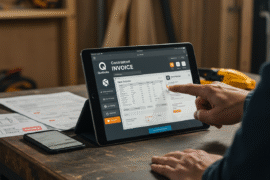This article may contain references to products or services from one or more of our advertisers or partners. We may receive compensation when you click on links to those products or services. Nonetheless, our opinions are our own.
The information presented in this article is accurate to the best of our knowledge at the time of publication. However, information is subject to change, and no guarantees are made about the continued accuracy or completeness of this content after its publication date.
When you finish college and enter the exciting time of adulthood, you may have to make a lot of decisions that could affect your financial future. One important decision is to begin investing. Let’s be honest: it might be hard. Financial markets can be hard, and managing your money can be scary. But one of the best things you can do for your finances is to start investing in your 20s. Investing early takes advantage of compound interest, which helps your money grow over time. We will help you learn the most important things to do to invest wisely and with confidence, whether you just graduated from college and have student loans or just got your first job. It will help you become independent and build a stable financial future.
- Your Financial Situation After Graduation
- Setting Clear Investment Goals for Your Future
- Creating a Budget That Helps Your Investment Journey
- Exploring Different Investment Options for New Investors
- The Importance of Having an Emergency Fund Before You Invest
- Staying Informed and Adapting Your Plan as You Grow
- Diversification is Essential
- Join a Retirement Plan Offered by Your Job
- Open an Individual Retirement Account (IRA)
- Conclusion
- Frequently Asked Questions
- Recommended Reads
Your Financial Situation After Graduation
Managing money can be hard when you go from school to work. It’s a good idea to stop and look at your finances. Make a simple budget that shows how much money you make and how much you spend. Keep track of things like your rent, student loan payments, everyday costs, and credit card bills. This information will help you make plans for the future.
Start by focusing on your financial goals. You may want to create an emergency fund, get rid of debt, or begin investing. Here are some key things to think about:
- Track Your Spending: Use budgeting apps or spreadsheets to see where your money goes.
- Create an Emergency Fund: Try to save 3-6 months’ worth of living expenses for unexpected costs.
- Know Your Debt: Understand the amounts, interest rates, and terms of your loans.
- Start Small with Investing: Even small amounts saved for retirement can grow a lot over time.
Here’s a Speedy Summary of Budgeting Essentials
| Category | Percentage of Income |
|---|---|
| Housing | 30% |
| Utilities | 10% |
| Food | 15% |
| Transportation | 10% |
| Debt Repayment | 15% |
| Savings/Investments | 20% |
You can build a strong foundation for a safe financial future by knowing where you stand financially and making smart choices. Take some time to learn about the choices you have. Don’t be afraid to ask for help or look for resources.
Setting Clear Investment Goals for Your Future
It’s important to have clear and specific goals when you think about your money in the future. People often call these SMART goals. Think about what you want your investments to do before you do anything else. Do you want to save up for a house, a trip, or your retirement? Writing down your goals will help you decide how much money you need to put in and where to put it.
When you know your goals well, divide them into:
- Short-term goals: These are things you want to accomplish in the next 1-3 years. Examples include saving money for a vacation or an emergency fund.
- Medium-term goals: These plans usually take about 3-7 years. This might include buying a car or paying for a wedding.
- Long-term goals: These are your dreams set for more than 7 years. They often focus on saving for retirement or investing for your children’s education.
| Goal Type | Example | Time Frame |
|---|---|---|
| Short-term | Emergency fund | 1-3 years |
| Medium-term | Home down payment | 3-7 years |
| Long-term | Retirement fund | 7+ years |
Creating a Budget That Helps Your Investment Journey
Creating your financial plan is important as you start your money journey. First, find out how much money you make each month after taxes. Next, list your living costs. This includes rent, utilities, groceries, and any subscriptions or memberships. Knowing these fixed costs can help you see how much you have left for savings and investments. You might think about organizing your expenses into:
- Needs: A home, food, getting around
- Wants: Eating out, fun activities
- Savings: Emergency fund, retirement savings
Once you list your expenses, it is easier to see where you can save money. Reducing your spending on food or entertainment can free up more money for investing. A common rule is the 50/30/20 guideline. It suggests dividing your money as follows:
| Category | Percentage |
|---|---|
| Needs | 50% |
| Wants | 30% |
| Savings & Investments | 20% |
This plan will not only help you meet your daily money needs, but it will also help you build wealth over time by slowly adding to your portfolio. If you’re just starting out, remember that every dollar counts. If you make a habit of investing regularly, even if it’s just a little bit, you can get good returns over time.
Exploring Different Investment Options for New Investors
When you are new to investing, it can feel like a lot. Still, it is important to look at different options to see what matches your financial goals and how much risk you can handle. Here are some choices to consider:
- Stocks: Investing in individual stocks can give high returns, but they also come with more risk. Start with companies that you know and trust.
- Exchange-Traded Funds (ETFs): These are like baskets of stocks that trade on exchanges. They offer a mix of stocks with less risk than individual stocks.
- Mutual Funds: These are managed funds that pool money from many investors to buy a mix of stocks and bonds.
- Robo-Advisors: If you don’t know where to start, think about using a robo-advisor. They set up and manage a mix of investments for you based on your risk level.
- Real Estate: Investing in real estate, either by owning property or using real estate investment trusts (REITs), can give you good income and diversification.
Creating a balanced investment plan often takes some practice since your preferences and the market change over time. Here’s a simple comparison table to help you evaluate these options:
| Investment Type | Potential Returns | Risk Level | Time Requirement |
|---|---|---|---|
| Stocks | High | High | Moderate |
| ETFs | Moderate to High | Moderate | Low |
| Mutual Funds | Moderate | Moderate | Low |
| Robo-Advisors | Moderate | Low to Moderate | Very low |
| Real Estate | Moderate | Moderate to High | High |
As you assess each investment option, consider your financial goals, how much time you have, and how much risk you feel comfortable with. Remember, it’s not about finding the ‘perfect’ investment. It’s about starting your path to building wealth.
Voted "Best Overall Budgeting App" by Forbes and WSJ
Monarch Money helps you budget, track spending, set goals, and plan your financial future—all in one app.
Get 50% OFF your first year with code MONARCHVIP
The Importance of Having an Emergency Fund Before You Invest
Think about how nice it would be to have some money saved up before you start investing. Your emergency fund is there to protect you. It protects you from unexpected costs like getting sick, your car breaking down, or losing your job. This safety net gives you peace of mind while you invest because you know you won’t have to take money out of your investments right away if something goes wrong. It can be thought of as a cushion for your money, which is good for your overall financial health.
Here are some important reasons to focus on creating an emergency fund:
- Security: Saving 3-6 months’ worth of living expenses can help you handle tough times without worry.
- Investment Focus: A strong emergency fund lets you focus on your investments instead of stressing about money troubles.
- Opportunity: When you feel secure with your money, you can take advantage of investment opportunities when they come up without hesitation.
To begin, take a look at this easy table. It can help you calculate how much you need to save for your emergency fund:
| Monthly Expenses | Target Emergency Fund (3 Months) | Target Emergency Fund (6 Months) |
|---|---|---|
| $2,000 | $6,000 | $12,000 |
| $3,000 | $9,000 | $18,000 |
| $4,000 | $12,000 | $24,000 |
Start by setting small, achievable goals for your emergency fund. It will grow over time and help you build a strong base for your future investments.
Staying Informed and Adapting Your Plan as You Grow
As you start investing, it’s important to stay up-to-date. The financial world is always changing, and what works now may not work later. Try to make it a habit to:
- Read Financial News: Sign up for reputable financial news sources to stay updated on market trends and economic shifts.
- Follow Influential Investors: Learn from experienced investors on social media or podcasts for tips and strategies.
- Network with Peers: Join investment groups or online forums to share your experiences and get ideas from other investors.
It’s a good idea to regularly check your investment strategy. Make changes as you learn more and as your life changes. A simple tracking table can help you keep everything organized:
| Investment Type | Initial Investment | Current Value | Notes |
|---|---|---|---|
| Stocks | $2,000 | $2,500 | Consider reallocating based on performance. |
| Bonds | $1,500 | $1,600 | Stable investment; plan to hold long-term. |
| Mutual Funds | $1,000 | $1,200 | Review fund performance quarterly. |
By keeping up with news and often checking your investments, you will be ready to handle the challenges of investing. This will help you as you grow in your financial journey.
Diversification is Essential
Investing is all about diversification. It helps lower risk and raise returns. By putting your money into different types of investments, industries, and areas, you can lessen the effects of big changes in one investment. Here are some key points to think about when diversifying:
- Investment Mix: Find the right blend of stocks, bonds, real estate, and other assets based on your risk tolerance, goals, and time frame.
- Industry Variety: Put your money into companies from different sectors like technology, healthcare, finance, and consumer products to lower risks from any specific area.
Join a Retirement Plan Offered by Your Job
As you explore investing in your 20s, joining a retirement plan offered by your employer can be extremely helpful. Many employers offer matching contributions, which can boost your savings significantly.
Open an Individual Retirement Account (IRA)
Young people in their 20s should open an individual retirement account (IRA). It helps you save for retirement outside of employer-sponsored plans and gives you tax breaks. If you start saving early, your money will grow over time, which will help you get ready for a comfortable retirement. Keep in mind that it’s never too soon to start planning for your money future.
Conclusion
One of the best things you can do to make sure your financial future is safe is to start investing in your 20s. You can build a strong base for long-term financial stability by using the right strategies, such as making a budget, setting clear financial goals, and investing in a variety of options. Every choice you make matters, whether you’re starting with a little bit of money or setting up an emergency fund. Keep your investments in line with your risk tolerance and financial goals. Don’t be afraid to change your plan as you learn more about how to manage your money. You are investing in your financial future and the peace of mind that comes from knowing you’re planning ahead when you stay informed, diversify your portfolio, and take advantage of opportunities like employer retirement plans and IRAs. Start with a small amount, keep it up, and you’ll see your money grow.
Frequently Asked Questions
Why is it crucial to start investing in my 20s?
Starting to invest in your 20s can help you secure your financial future. The earlier you start, the more time your money has to grow through compounding. Your initial investments can generate earnings, and those earnings can generate even more money as time goes on.
What are some good choices for beginners who want to invest?
As a beginner, it’s a good idea to start with low-cost index funds or ETFs. These funds cover a broad market and generally have lower fees than actively managed funds. You can also explore individual stocks if you feel ready, but starting small is wise. Other options include high-yield savings accounts, CDs, or retirement accounts like a 401(k) or IRA.
How much money should I start investing with?
You don’t need a lot of money to start investing. Many platforms let you begin with just $100 or less. The most important thing is to develop the habit of investing regularly.
How can I minimize risks when investing?
To reduce risks, diversify your investments across different areas like stocks, bonds, and real estate. Also, consider your risk tolerance and choose investments that match your comfort level with risk.

Reviewed and edited by Albert Fang.
See a typo or want to suggest an edit/revision to the content? Use the contact us form to provide feedback.
At FangWallet, we value editorial integrity and open collaboration in curating quality content for readers to enjoy. Much appreciated for the assist.
Did you like our article and find it insightful? We encourage sharing the article link with family and friends to benefit as well - better yet, sharing on social media. Thank you for the support! 🍉
Article Title: Investing in Your 20s: A Smart Guide to Building Wealth and Financial Freedom
https://fangwallet.com/2025/07/26/investing-in-your-20s-a-smart-guide-to-building-wealth-and-financial-freedom/The FangWallet Promise
FangWallet is an editorially independent resource - founded on breaking down challenging financial concepts for anyone to understand since 2014. While we adhere to editorial integrity, note that this post may contain references to products from our partners.
The FangWallet promise is always to have your best interest in mind and be transparent and honest about the financial picture.
Become an Insider

Subscribe to get a free daily budget planner printable to help get your money on track!
Make passive money the right way. No spam.
Editorial Disclaimer: The editorial content on this page is not provided by any of the companies mentioned. The opinions expressed here are the author's alone.
The content of this website is for informational purposes only and does not represent investment advice, or an offer or solicitation to buy or sell any security, investment, or product. Investors are encouraged to do their own due diligence, and, if necessary, consult professional advising before making any investment decisions. Investing involves a high degree of risk, and financial losses may occur including the potential loss of principal.
Source Citation References:
+ Inspo
There are no additional citations or references to note for this article at this time.












































